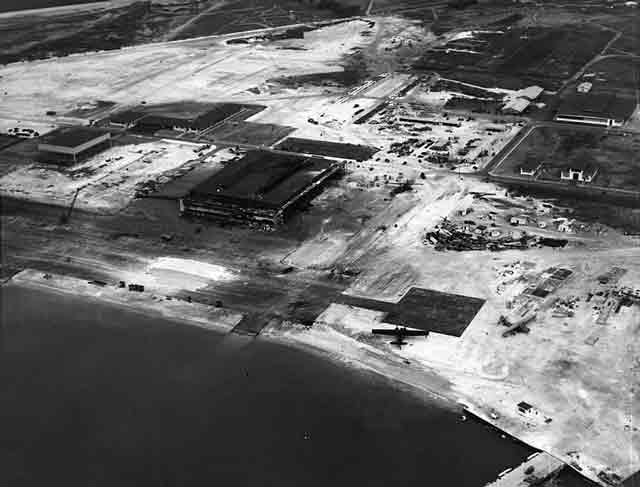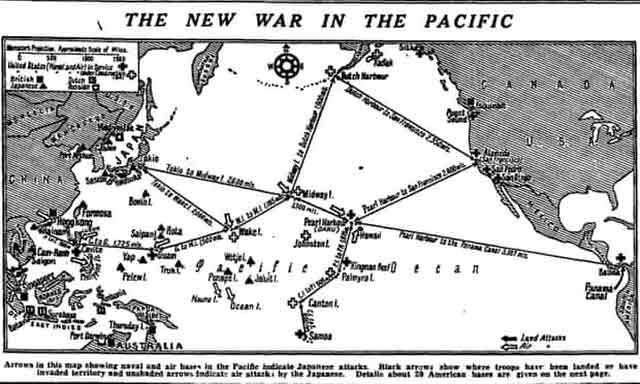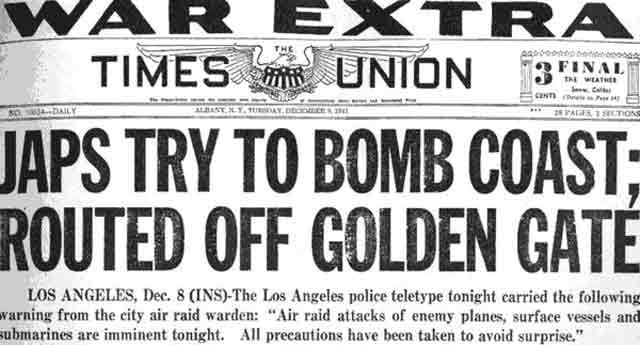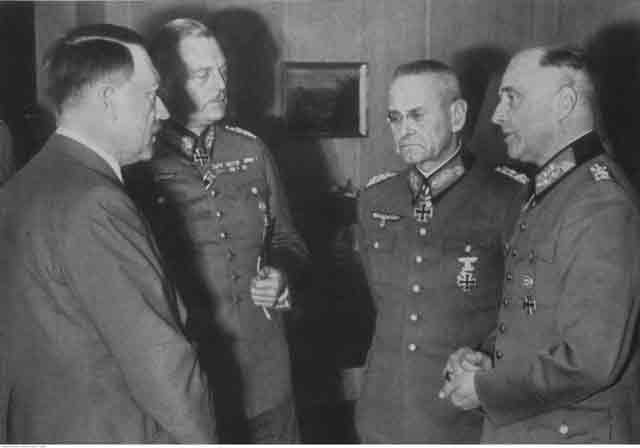Tuesday 9 December 1941
 |
| A staff member at the Japanese Consulate in Chicago is startled by a visitor on the morning of 9 December 1941. He is helping to destroy or remove documents, with most confidential papers already having been destroyed. As the United States and the Empire of Japan are now in a state of war, all diplomats are to be returned unharmed to their own countries. |
Eastern Front: The Soviet offensive and German withdrawals accelerate on 9 December 1941. South of Moscow, General Heinz Guderian is trying to get his exposed 2nd Panzer Army west from Tula, but supply difficulties are exacerbating the process. Army Group Center has promised to fly in gasoline and diesel oil, but the planes are diverted to Third Panzer Army in the northwest sector around Moscow. In frustration, Guderian calls up Field Marshal Fedor von Bock, commander of Army Group Center, and asks pointedly whether the OKH and OKW commands are being given accurate information about the situation - the clear implication being that von Bock may be painting too rosy a picture of the seriousness of the situation. For the first time, Guderian also hints darkly at a much deeper problem among the men, namely, morale problems. The men, he hints, are wondering if they are being led by fools. These insinuations, of course, are all directed at von Bock.
 |
| Japanese soldiers enter the International Settlement at Shanghai, 9 December 1941. Their mission is to intern enemy aliens (CSUN). |
Von Bock is becoming anxious, too. South of Guderian's position, Second Army begins extricating itself as well, giving up Yelets. He telephones General Franz Halder, chief of OKH operations, and demands reinforcements. The manpower shortage has become so acute, von Bock complains, that he has had to convert everyone except tank drivers into the infantry. While giving cooks and supply officers rifles may help in the short term, he points out that large sections of the front are held by isolated strongpoints with nothing behind them. The call degenerates into a virtual shouting match, with Halder claiming that the Soviets will soon run out of men themselves, von Bock replying that "By then, the army group will be kaputt!" and Halder lamely responding, "The German soldier does not go kaputt." The call winds up with Halder promising to send "whatever small reserves [that can] be scraped together."
 |
| US airfields across the country take precautions to avoid disasters similar to those in Pearl Harbor, where rows of aircraft were easily destroyed because they were tightly packed together. "Planes and other equipment at the Naval Air Station at Quonset Point are dispersed in case of a surprise enemy attack, on December 9, 1941, taking a lesson from the attack on Pearl Harbor." (Naval History and Heritage Command). |
The situation around Moscow presents no good options. In his orders to the army commands, von Bock points out that simply withdrawing and making "an excursion into nowhere" will not provide any more safety. He does, however, authorize a retreat of between 60 and 90 miles a new line running from Rzhev to Gzhatsk and through Orel to Kurk. Field Marshal Günther von Kluge
, commander of 4th Army which is positioned directly to the west of Moscow, points out to von Bock that even this retreat will only delay Soviet attacks for a few days. In despair, von Bock tells von Kluge:
I am at the point of sending the Fuehrer a personal telegram telling him that I am confronted with decisions here that go far beyond the military.
By this, von Bock may mean a retreat such as Napoleon's army undertook in 1812 which destroyed the French Army.
 |
| Aerial view of the hangar area at Kaneohe Bay, Oahu on 9 December 1941. This view is to the southeast, roughly the direction that the attackers would have taken. US Naval Historical Center. |
The Soviets, meanwhile, are sending trainloads of fresh soldiers from their reserves straight to the front. The Stavka, however, is not pleased with their performance. The West Front on the high road to Moscow issues a pointed directive on 9 December:
Some of our units are pushing the enemy back frontally instead of going around him and encircling him. Instead of breaking through the enemy's fortifications, they stand before them and complain about problems and heavy losses. These negative modes of operations give the enemy the chance to redeploy to new lines, regroup, and organize resistance anew.
Both sides, thus, are beginning to complain about their soldiers being insufficiently stoic, a reflection of the truly brutal conditions everyone is facing in the snow and frost.
 |
| The New York Times on 9 December 1941 attempts to cover events far away with lots of strong rhetoric but very few accurate details of what is going on. Events at Pearl Harbor are still murky and only the loss of one battleship is claimed. Heroic headlines such as "Fleet now is fighting" reflect more wishful thinking and rumors than reality. The US Fleet has not attacked the Japanese main strike force, Kido Butai, at all and does not even know where it is. |
Battle of the Pacific: The Japanese begin operating fighters out of airfields at Singora and Patani, Thailand. These are meant to cover the advance down the Malay Peninsula toward Singapore. The RAF attempts a raid on Singora from RAF Butterworth, but Japanese Zeros are waiting and shoot down all of the bombers as they are taking off except for one. That lone bomber, a Bristol Blenheim that is flown by No. 62 squadron leader Arthur Scarf, continues on its mission despite numerous attacks and bombs the target. Squadron Leader Scarf is mortally wounded during the return flight but still manages to crash-land his Blenheim at Alor Star without injury to any of his crewmen. Arthur Scarf dies two hours later. He later is awarded the Victoria Cross posthumously, and two of his crewmen also are decorated for the mission. Arthur Scarf's VC is on display at the Royal Air Museum in London.
 |
| "Aerial view of the hangar area of the U.S. Naval Air Station Kaneohe Bay, Oahu, Territory of Hawaii on 9 December 1941, two days after the Japanese air attack destroyed nearly all of the station's patrol planes. Note the wrecked hangar in the center. There are at least six Consolidated PBY "Catalina" flying boats on the ramp and around the hangars. In the right foreground is a pile of PBY´s wrecked during the attack." The devastation is so bad in Hawaii and information so scant that US Army Air Force aerial reconnaissance is necessary just to find out what happened. Normally, you would do this only after you attack someone else's base. Some planes are intact because they were on patrol. National Archives. |
Battle of the Mediterranean: The Axis forces continue to retreat from the Tobruk area. The Italian Bologna Division which holds a key strongpoint on the southern end of the Tobruk perimeter is sent some trucks which enable most of the men to escape west in the early morning hours. Their departure confirms the full relief of Tobruk as a result of Operation Crusader. Both sides have suffered heavy losses, but the British have regained the initiative in North Africa. General Rommel is setting up a new line anchored on Gazala while the British begin reorienting troops and commands for a continued advance to the west.
 |
| The 9 December 1941 Manchester Guardian publishes a helpful map for readers who are unfamiliar with all the strange places from the Pacific Ocean that are suddenly in the news. The map shows distances from Pearl Harbor to the Panama Canal, San Fransisco, and elsewhere. The newspaper's lead opens with, "Japan could not have invented a plan of attack better calculated to unify the United States and turn it overnight into a determined fighting nation. " |
Special Operations: The British send No. 6 Commando and No. 12 Commando, along with attached Norwegian troops, on a special mission against the town of Florø on the island of Florelandet in Norway (the country's westernmost town). However, the mission, Operation Kitbag, turns into a major embarrassment. First, some soldiers prime their grenades improperly, causing an explosion that kills six men aboard HMS Prince Charles. Then, the ship's commander cannot even find the proper fjord (between the Botnafjorden and Solheimsfjorden). The ship turns around and returns to port, the mission canceled. This illustrates the difficulties of such operations and the need for better preparation.
 |
| In its 9 December 1941 edition, the NY Times notes with approval that "President's Power Greatly Enlarged." |
American Homefront: The nation is still stunned by the attack on Pearl Harbor. President Roosevelt gives a fireside chat that publicizes the declaration of war against the Empire of Japan. Ordinary men flock to enlistment centers, including future Hall of Famer Cleveland Indians pitching ace Robert "Bob" Feller. Feller becomes the first American professional athlete to enlist. He demands to go into combat despite an exemption due to his father's ill health and ultimately is assigned to the USS Alabama. Among the battles that Feller participates in are the Battle of Tarawa and the Battle of the Philippines Sea. Bob Feller later resumes his pitching career with great success and passes away on 15 December 2010.
 |
| With little information flowing about the newly declared war, newspapers across the country print rumors instead. The 9 December 1941 Albany, New York Times Union, for instance, trumpets a supposed Japanese air raid on San Francisco that never happened. However, to be fair, they are just reprinting and in some cases expanding upon inaccurate stories from elsewhere that nobody is in a position to refute except the US government - and it doesn't have a clear view of the picture yet, either. So, inaccurate rumors compound upon rumors. |
Future History: Lloyd Vernet Bridges III is born in Los Angeles, California. He is nicknamed "Beau" by his parents, the famous actors Lloyd Bridges and Dorothy Bridges, after the son of character Ashley Wilkes in "Gone With The Wind" (1939). Beau Bridges follows in the footsteps of his parents and becomes an actor, getting his first film role in "Force of Evil" (1948), and goes on to a very successful film career of his own. As of 2019, Beau Bridges remains a force in the entertainment industry.
 |
| Blackouts and curfews are imposed all along the US west coast. Here, a newsroom in San Francisco operates in the dark (in more ways than one) during the blackout on 9 December 1941. |
December 1941December 1, 1941: Hitler Fires von RundstedtDecember 2, 1941: Climb Mount NiitakaDecember 3, 1941: Hints of Trouble in the PacificDecember 4, 1941: Soviets Plan CounteroffensiveDecember 5, 1941: Soviets Counterattack at KalininDecember 6, 1941: Soviet Counterattack at Moscow BroadensDecember 7, 1941: Japan Attacks Pearl HarborDecember 8, 1941: US Enters World War IIDecember 9, 1941: German Retreat At MoscowDecember 10, 1941: HMS Prince of Wales and Repulse SunkDecember 11, 1941: Hitler Declares War on USDecember 12, 1941: Japanese in BurmaDecember 13, 1941: Battle of Cape BonDecember 14, 1941: Hitler Forbids WithdrawalsDecember 15, 1941: The Liepaja MassacreDecember 16, 1941: Japan Invades BorneoDecember 17, 1941: US Military ShakeupDecember 18, 1941: Hitler Lays Down the LawDecember 19, 1941: Brauchitsch Goes HomeDecember 20, 1941: Flying Tigers in ActionDecember 21, 1941: The Bogdanovka MassacreDecember 22, 1941: Major Japanese Landings North of ManilaDecember 23, 1941: Wake Island Falls to JapanDecember 24, 1941: Atrocities in Hong KongDecember 25, 1941: Japan Takes Hong KongDecember 26, 1941: Soviets Land in the CrimeaDecember 27, 1941: Commandos Raid NorwayDecember 28, 1941: Operation Anthropoid BeginsDecember 29, 1941: Soviet Landings at FeodosiaDecember 30, 1941: Race for BataanDecember 31, 1941: Nimitz in Charge2020






































